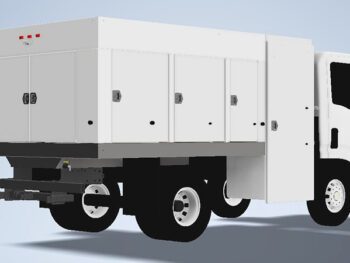
Lawn care operators (LCO) and pest control business owners who are focused on growth can quickly outpace their fleet of pickup truck bed sprayers and skid sprayers. If you’re having trouble servicing all of your accounts, it may be time to step up to a custom spray truck.
Managing and maintaining a fleet of smaller trucks can be cumbersome and costly. A larger spray rig will allow you to service your routes more efficiently and profitably.
But where do you get started? With so many choices available, it can be difficult to determine what will meet your current and future needs. Here are a few things to consider on your quest to find the perfect spray truck:
1. Capacity
Most herbicide labels suggest a dosage per 1,000 square feet. So how do you figure out how much capacity you need to be able to service your customers? For example, a spray truck with a 500-gallon tank and a product application rate of 2 gallons per 1,000 square feet:
(tank capacity ÷ application rate) x 1,000 sq. ft. = sq. ft. covered by tank
- tank capacity (500 gal.) divided by
- application rate (2 gal.) = 250
- multiplied by 1,000 sq. ft.
- = 250,000 sq. ft.
You can also calculate mix ratio based on tank size, your desired rate of spray, and suggested label spray rate. Because the product label lists ounces per 1,000 sq. ft., you have to determine how many 1,000 sq. ft. areas are in your result to find your mix ratio. In this example, the answer is 250 (250,000 ÷ 1,000).
Since you have 250 of those 1,000 sq. ft. areas, and an application rate of 2 gallons per sq. ft., you will need to mix 500 ounces of product (250 x 2 ounces) with your 500 gallons of water.
Let’s convert those ounces to gallons. There are 128 ounces in a gallon, so divide 500 by 128 (500 ÷ 128), which equals about 4 gallons of product as the proper mix for 500 gallons of water.
(tank capacity ÷ application rate) x label rate = ounces of product needed
- tank capacity (500 gal.) divided by
- application rate (2 gal.) = 250
- multiplied by label rate (2 gal.)
- = 500 ounces of product needed
Pop quiz! Technician A uses a 200 gal. tank with a spray gun calibrated for 3 gal. per 1,000 sq. ft. The product label recommends applying 4 ounces per 1,000 sq. ft. How many gallons of herbicide should he mix in the tank and how much area will it cover?
Answer: Technician A should mix about 2 gallons of herbicide in the tank and it would cover about 67,000 sq. ft.
Bonus round! Technician B applies the same chemical above, but at 2 gal. per 1,000 sq. ft. How much product is needed and how far will it go? Answer: Technician B would need about 3 gallons of product and would get about 100,000 sq. ft. from a 200 gallon tank.
Both technicians are applying the same 4 ounces per 1,000 sq. ft. Reducing the amount of water means technicians can cover more lawns, but must adjust herbicide rates to account for the increased area.
2. Tank Configuration
It’s a good idea to add 20-30% to your total gallons needed for future growth. You don’t want to invest in expensive equipment that won’t meet your needs in the next 2-5 years.
- How many properties does my business serve?
- What is the total square footage?
- How many are commercial vs. residential?
- What chemical products do I use?
Chemical Tanks
Most larger spray trucks can carry about 400-600 gallons. Depending on your service offerings, you’ll need to decide how many tanks are needed for different chemicals. Do you want a truck dedicated to a single service, or a truck that can perform several applications at each property? Here are a few popular chemical tank configurations:
- 400/150/60 – Cool season lawns
- 300/250/60 – Warm season lawns
- 300/150/150 – Plant Health Care (PHC)
- 200/200/150/60 – Combo
Tank construction is also an important factor. Polyethylene tanks (also poly or PE) are one-piece designs that are stronger than fiberglass and less prone to leaks.
Agitation
Mechanical agitation – A shaft with paddles, typically driven by an auxiliary shaft from the pump that runs through the center of the tank. Mechanical agitation is more suited for dry chemicals. Due to complexity and more moving parts, this system can be difficult to service maintain.
Jet agitation – A pressure line (not bypass) that returns product to the tank through a nozzle. This method has a lot of adjustability, but requires a pump setup with enough volume for a second pressure line.
Bypass agitation – Excess spray material is returned to the tank through a pressure relief or other valve. Bypass agitation is simple and inexpensive, but the low pressure return is prone to clogging and undesirable spray applications.
Sparger agitation – Typically a specialized nozzle attached to a length of tubing inside the tank. These systems are known for their efficiency and uniform agitation.
3. Pump Selection

Selecting the right sprayer pump or pumps for your application requires an understanding of the various styles and correct operation to maximize performance.
It’s easy to get caught up in spec sheets and comparing numbers on a chart. None of that is very important. The main question you want to ask is: does my setup have enough pressure to push product through the plumbing system and out the nozzle at the desired rate?
Most pump manufacturers express this as GPM (gallons per minute). The formula to find GPM is 60 divided by the seconds it takes to fill a one gallon container (60 ÷ seconds = GPM). Example: A one gallon container fills in 5 seconds. 60 ÷ 5 = 12 GPM.
Select pumps with a GPM 20% greater than the minimum application flow rate. This extra rate guarantees optimal system operation by accounting for additional pressure needs from system plumbing, components, any additional attachments, as well as fluid characteristics.
4. Labor – Your Biggest Expense
Spending more up front for a larger spray truck is less expensive over time. If you think small, you may have to purchase a supplemental unit to meet new demand, which means hiring and training another employee.
Now instead of one truck that meets your needs and one technician, you have two vehicles and two technicians to do the same job. This not only doubles taxes, fees, maintenance, and insurance on equipment – but doubles payroll and other costs.
Don’t forget about downtime. Time is money. Technicians making trips to stock up on supplies or refill tanks kills your productivity (and profit). You need a spray truck that has ample storage so that your service team can make it through their day.
5. Customization

Finally, be sure to work with a custom spray truck builder who understands your needs and business goals. Don’t allow yourself to be pushed towards an “in-stock” unit or a certain model with a catchy name, but limited or unwanted features.
Questions to ask yourself:
- What is your budget?
- What chemicals will you be spraying?
- Do you need to mix chemicals from different tanks?
- Will the unit only be used for lawn applications?
- Do you offer (or plan to offer) other services like tree and shrub care?
- What is the maximum spray height needed?
- Will multiple technicians use the same truck?
- How will your logos and graphics look on the truck?
FabMetals has built spray trucks for top lawn care and pest control professionals for over 30 years. Contact us today, and we’ll get started on building yours.



